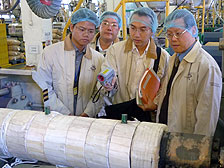
Strengthening the legal regulation on responding to oil spills at sea
Thứ tư, ngày 20 tháng 03 năm 2013 cập nhật lúc 02:17
Vietnam’s waters are an open sea connecting the Pacific and Indian Oceans. It is among the maritime routes with an enormous amount of traffic, of which 70% is oil tanker. As a result, Vietnam is facing the risk of pollution caused by oil spills. Implementing the regulation on responding to oil spills of the Government is a necessity given the context that our country does not have a long-term strategy to cope with this type of disaster.
According to the Institute of Marine Environment and Resources - Institute of Science and Technology of Vietnam, from 1989 to the present, our water have seen about 100 oil spills caused by ship accidents which spilled into the sea from a few dozens to hundreds of tons of oil. The oil spills usually occur in March and April in the Central while in the North, it is May and June.
Statistics show that from 1992 to 2008, oil spills in the Vietnamese waters came from various causes. In particular, oil spills with amount of 7-700 tons were mainly due to stranded ships while oil spills of over 700 tons were mostly due to collisions at sea during the transportation.
Oil spills pollute the marine environment and seriously impact the ecosystem of mangroves, sea grass, intertidal sand, lagoons and coral reefs. Oil contains many different components which change and destroy biological cell structure. Sometimes they can annihilate an entire population. Oil seeped into coastal sand and mud can cause impact that lasts very long. Oil-polluted water leads to fish die-off due to lack of dissolved oxygen. Oil clinging to the land, stone embankments, shore of islands affects landscape view and causes unpleasant odors, leading to heavy damages to the tourism industry. Oil spills also affect the operation of fishing ports and ship building and repair facilities.
A survey at Lach Bang fishing port, Tinh Gia, Thanh Hoa, the place where thousands of fishing ships from different regions often anchor at, showed that water pollution in this area has reached an alarming level due to oil sludge discharged from ships. 10 years ago, this estuary was home to a rich mangrove ecosystem. Now, almost the entire area of mangrove is dying due to oil contamination, leading to the extinct of the local brackish-water fauna and flora. Also, continuous incidents of oil pollution here caused the loss of hundreds of hectares of aquaculture, forcing many families to give up their business.
The most recent oil spill was the incident of Racer Express (Panama) with tonnage of more than 43,000 tons, which occurred on January 11, 2012. The ship anchored at Dung Quat port and spilled an amount of 1,000 liters of FO oil into the sea.
Therefore, oil spill can be considered as one of those that cause the biggest economic loss among the environmental incidents caused by humans.
Implementing the regulation on responding to oil spills
The Decision on issuance of the regulation on responding to oil spills of the Prime Minister has taken effect from March 1, 2013. This regulation provides for the preparation and organization to respond to oil spill and remedy its consequences, as well as the responsibilities of organizations and individuals regarding oil spills in the territory and waters Vietnam.
According to the regulation, oil spill response is divided into three levels: local, regional and national levels. The extent of the spill is also divided into three levels: small (volume of spill of less than 20 tons), medium (from 20 tons to 500 tons), and large (over 500 tons).
For oil spills at sea, based on specific situations, the collected oil can be temporarily seized for reuse and the ship causing the spill can be arrested for compensation assurance. For oil spills in the port area, if the owner of the ship causing the spill has not set up a compensation guarantee fund, the port authority, local competent authority or the responding unit can submit a complaint to the Court to request an arrest to ensure compensation for response costs and damages and losses caused by the incident.
This regulation is widely considered a "summer rain" given the serious "lack of law" on protecting marine natural resources today. In addition, experts said that, to enhance the implementation and supervision of oil spills, Vietnam should establish a Committee for oil spill response and issue a strategy on responding to oil spills at sea with a guideline of proactive prevention, rapid remedy and minimizing damages caused by oil pollution.
T.Minh
Source:






















